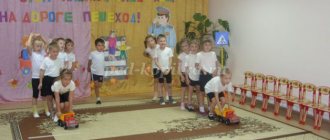Age category: for children of senior preschool and primary school age (6-8 years).
Purpose of the game: development of dexterity, mobility, auditory memory, attentiveness, accuracy and speed of reactions, motor, communicative, cognitive, intellectual, musical and creative abilities, repetition and consolidation of knowledge of the letters of the Russian alphabet.
Equipment: children's colored crayons.
Progress of the game.
Any adult acts as the leader. Before the start of the game, on the playground where the game will be played, 11 even straight lines parallel to each other, located at a distance of one step from each other, are drawn using children's colored crayons. Three participants take a place on the first line, and the leader stands on the last, eleventh, turning to face the players. Mentally to himself, he pronounces all the letters of the Russian alphabet in order until the participants stop him by loudly shouting: “Stop!” Then the presenter says out loud the letter of the alphabet on which he is currently stopped (for example, it could be the letter “B”). Participants must quickly remember and sing out loud a song that begins with the letter “B.”
For example, the first participant sings:
There was a birch tree in the field, There was a curly birch tree in the field, Lyuli, lyuli stood, Lyuli, lyuli stood. (Russian folk song.)
The second participant, for example, can sing the following song:
Cornflower, cornflower, my favorite flower. Tell me, soon you will turn blue in the rye. (Russian folk song.)
And the third player can, for example, sing: In the forge, in the forge, In the forge, in the forge, In the forge, young blacksmiths, In the forge, young blacksmiths. They forge, they forge, They forge, they forge, They forge, they condemn, They hammer with hammers. (Russian folk song.)
Those of the guys who remembered and sang songs with the indicated letters successfully move to the second line, and the one who could not remember must run away from the leader until he catches him. Only after the leader touches him with his hand does the child have the right to take a place on the second line next to the other participants, but he is awarded 1 penalty point. Then the game continues according to the same rules until one of the players reaches the leader along the lines and touches him with his hand. It is this player who will be considered the generally recognized winner, who can temporarily change places with the leader, taking his rightful place, in order to repeat the game. The presenter, in turn, takes the place of this participant until the next victory of one of the children. The game can be played in several rounds until all players play the role of leader. In addition, the participant who performed the best songs, Russian folk or popular, in the opinion of the presenter and other players, can be awarded some kind of prize phantom intended for the best performer of songs.




